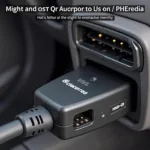The OBD2 scanner code P0125, indicating an issue with the engine coolant temperature (ECT) sensor circuit, is a common headache for car owners. This article will dive deep into understanding this code, its symptoms, causes, and possible solutions.
Understanding OBD2 Code P0125
Your car’s engine control module (ECM) heavily relies on the ECT sensor to regulate fuel delivery and ignition timing for optimal performance and fuel efficiency. The ECT sensor constantly monitors the engine coolant temperature and relays this data to the ECM. When the ECM detects a problem with the ECT sensor circuit, specifically “insufficient coolant temperature for closed loop fuel control,” it triggers the P0125 code.
Recognizing the Symptoms
While the check engine light illuminating on your dashboard is the most obvious sign, other symptoms might accompany the P0125 code:
- Poor fuel economy: Inaccurate temperature readings can lead to a richer fuel mixture, negatively impacting your gas mileage.
- Difficulty starting: A cold engine requires a richer fuel mix to start properly. A faulty ECT sensor can hinder this process.
- Engine overheating: Although less common, a malfunctioning ECT sensor might not alert the ECM about overheating, potentially leading to severe engine damage.
- Rough idling or stalling: An incorrect temperature reading can cause the engine to idle erratically or even stall, especially when cold.
Common Causes of P0125 Code
Several factors can contribute to a P0125 code:
- Faulty ECT Sensor: The most common culprit is a malfunctioning sensor, often due to age, wear and tear, or exposure to extreme temperatures.
- Wiring Issues: Damaged, corroded, or loose wiring within the ECT sensor circuit can disrupt communication between the sensor and the ECM.
- Faulty Thermostat: A stuck-open thermostat can prevent the engine from reaching optimal operating temperature, triggering the P0125 code.
- Low Coolant Level: Insufficient coolant can lead to inaccurate temperature readings by the ECT sensor.
- Damaged ECM: While rare, a faulty ECM can also be responsible for the P0125 code.
How to Diagnose the Problem
Accurately diagnosing the root cause of the P0125 code is crucial before attempting any repairs. Here’s a step-by-step guide:
- Retrieve the Code: Connect your OBD2 scanner to your car’s OBD2 port and retrieve the stored trouble code.
- Visually Inspect the ECT Sensor and Wiring: Look for any signs of physical damage, corrosion, or loose connections.
- Check the Coolant Level: Ensure the coolant level is within the recommended range.
- Test the ECT Sensor: Use a multimeter to check the sensor’s resistance against the manufacturer’s specifications.
- Inspect the Thermostat: Check the thermostat’s operation to ensure it’s opening and closing at the correct temperatures.
Fixing the P0125 Code
The repair method for the P0125 code will depend on the diagnosed cause:
- Replace the ECT Sensor: If the sensor is faulty, replacing it is a straightforward procedure.
- Repair or Replace Damaged Wiring: Address any wiring issues by repairing or replacing the affected sections.
- Replace the Thermostat: A faulty thermostat needs replacement to ensure proper engine temperature regulation.
- Top up Coolant: Refill the coolant to the appropriate level and check for leaks.
- Consult a Mechanic: If the ECM is suspected to be faulty, consult a qualified mechanic for diagnosis and repair.
Importance of Addressing P0125 Code
Ignoring the P0125 code can lead to more significant issues and costly repairs down the line. Addressing the problem promptly will ensure:
- Optimal Engine Performance: A properly functioning ECT sensor contributes to smooth engine operation and fuel efficiency.
- Preventing Further Damage: Ignoring the code can lead to more severe problems like catalytic converter damage or engine overheating.
- Passing Emissions Tests: A faulty ECT sensor can impact your car’s emissions, leading to failed emissions tests.
Tips for Preventing Future P0125 Codes
While some causes like sensor failure are unavoidable, these tips can help minimize the chances of encountering the P0125 code again:
- Regular Maintenance: Follow your car manufacturer’s recommended maintenance schedule, including coolant flushes and thermostat inspections.
- Quality Coolant: Always use high-quality coolant that meets your vehicle’s specifications.
- Visual Inspections: Regularly inspect the ECT sensor and wiring for any signs of damage or wear.
Conclusion
The OBD2 code P0125, though common, shouldn’t be ignored. By understanding its causes, symptoms, and solutions, you can effectively address this issue, keep your car running smoothly, and avoid potentially costly repairs in the future.
FAQs About OBD2 Code P0125
Can I still drive my car with a P0125 code?
It’s not recommended to drive your car for extended periods with a P0125 code. While short distances might be possible, ignoring the issue can lead to further damage and safety hazards.
How much does it cost to fix the P0125 code?
The cost of repair depends on the underlying cause. A simple ECT sensor replacement can range from $50 to $150, while a faulty thermostat replacement might cost between $100 and $300.
How often should I replace my ECT sensor?
While there’s no set replacement interval, it’s generally recommended to inspect the ECT sensor every 60,000 miles or during major coolant system maintenance.
Can I replace the ECT sensor myself?
Replacing the ECT sensor is usually a simple procedure that most DIYers can handle with basic tools. However, if you’re uncomfortable with car repairs, it’s best to consult a professional.
What happens if I clear the code without fixing the problem?
Clearing the code without addressing the root cause will only temporarily turn off the check engine light. The code will reappear once the ECM detects the issue again.
Looking for more information on other OBD2 codes or car diagnostics?
Check out our other articles on:
We provide comprehensive guides and resources to help you understand and resolve various car problems.
Need further assistance with diagnosing or fixing car issues? Don’t hesitate to contact our expert team via WhatsApp: +1(641)206-8880, or Email: [email protected]. We offer 24/7 customer support to address all your automotive needs.

